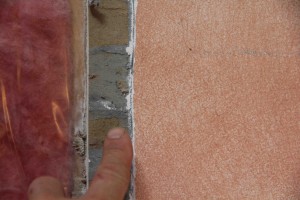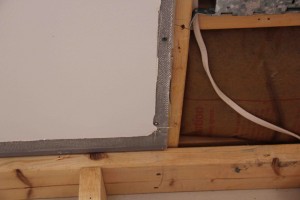Blending New Wallboard To Old Wallboard
Adding New Walls Next to Old Plaster Walls
 I run a remodeling company and on many projects we find ourselves removing portions of rooms to access pipes and wires and later blending new wallboard to old wallboard. sounds simple enough and it is if you take a few preparation steps.
I run a remodeling company and on many projects we find ourselves removing portions of rooms to access pipes and wires and later blending new wallboard to old wallboard. sounds simple enough and it is if you take a few preparation steps.
Many folks feel that you have to apply a skim coat over the whole wall. Unless the old wall is in bad shape there is no need to do this.
Blending the New Wall To Old:
We first determine how far back we have to remove our walls and always cut a seam at the nearest wall stud, or add a wall stud if needed. By using wall studs as backing we usually do not need to add additional nailers for the new and old wall union.
Procedure:
- We locate the center of an existing wall stud. Stud finders work reasonably well or a the tried and true “finish nail” method works too.
- Using a level we plumb a line down the center of the wall stud.
- Cut the plaster or drywall at the line by scoring repeatedly with a utility knife or with a multi-tool and plaster blade.
- Remove the wall board that you need to.
- Go back to the existing wall board and “lightly” score the plaster surface approximately 1.5 inches in fro the cut edge.
- Using a utility knife, putty knife or old beater chisel try to remove just the plaster and leave the paper on the wall board. The goal here is to create a small rabbit or groove to accept mesh tape and some new plaster. If the wall is old plaster then try to chisel out a small about of plaster.
- Cut these “rabbits or grooves” everywhere that new wall board will meet old on the walls and ceiling.

- Install new dry wall screws into the old board to secure this seam
- Install the new board in the same fashion
- Cover seam with mesh tape
- Apply a skim coat of veneer plaster over seam
- After seams have set plaster the wall if desired or apply additional drywall compound blending coats to the seam . Drywall compound is easier to blend and sand than plaster.
Note – the old wallboard must be in good shape to do this and clean. We usually scuff the old paint with sand paper or alternatively you can prime the old surfaces.
Blending new wallboard to old wallboard is one way to save you time and money on a remodeling project. the key is to know when it is feasible to save the old wall and when it makes sense to tear it out and replace it. This decision is best made on an individual basis and with an on site inspection of the wall condition.











